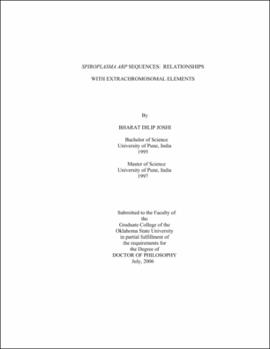| dc.contributor.advisor | Melcher, Ulrich K. | |
| dc.contributor.author | Joshi, Bharat Dilip | |
| dc.date.accessioned | 2013-11-26T08:22:54Z | |
| dc.date.available | 2013-11-26T08:22:54Z | |
| dc.date.issued | 2006-07 | |
| dc.identifier.uri | https://hdl.handle.net/11244/6651 | |
| dc.description.abstract | Scope and Method of Study: Spiroplasmas, members of Class Mollicutes, are scattered over wide host and geographic niches. Those which are plant pathogenic, such as Spiroplasma citri, are transmitted from plant to plant by homopteran insect vectors, leafhoppers, and cause devastating damages to several crops world-wide. A variety of model systems are available to study the transmission of phytopathogenic spiroplasmas by leafhoppers, their predominant vectors. Spiroplasma citri-Circulifer tenellus is one such system. Because spiroplasmas can be cultured in artificial media, they offer an excellent means to investigate the complex molecular interactions underlying the transmission of S. citri by the insect vector C. tenellus. Evidence suggests that an S. citri membrane protein, spiroplasma adhesion related protein 1 (SARP1), is involved in the adhesion of S. citri cells to tissue-cultured C. tenellus cells and, thus, is thought to be a putative adhesin. The gene encoding SARP1 (arp1) has been isolated, cloned and characterized. In this study, Southern blot hybridizations, PCR, cloning, sequencing and sequence comparisons of S. citri chromosomal and extrachromosomal DNAs were performed to investigate the relationships of the arp genes present on them with insect transmissibility and plant pathogenicity of various members of Class Mollicutes. | |
| dc.description.abstract | Findings and Conclusions: In this dissertation, arp1 is shown to be present on a novel, indigenous plasmid, pBJS-O, in S. citri BR3-3X. Furthermore, evidence of arp1-related sequences on the chromosomal DNA in certain spiroplasmas and the partial characterization of plasmids from two S. citri strains that lack arp1, S. citri ASP-1 and R8A2, is presented. The presence of multiple plasmids in the extrachromosomal DNAs of S. citri BR3-3X and R8A2 is also shown. Taken together, the data presented suggest that SARP1 may be sufficient, but not necessary, for S. citri transmission by C. tenellus and the differences in host species, geographical niches and maintenance regimes of spiroplasmas can lead to differences in their plasmid content. | |
| dc.format | application/pdf | |
| dc.language | en_US | |
| dc.rights | Copyright is held by the author who has granted the Oklahoma State University Library the non-exclusive right to share this material in its institutional repository. Contact Digital Library Services at lib-dls@okstate.edu or 405-744-9161 for the permission policy on the use, reproduction or distribution of this material. | |
| dc.title | Spiroplasma arp sequences: Relationships with extrachromosomal elements | |
| dc.contributor.committeeMember | Mort, Andrew J. | |
| dc.contributor.committeeMember | Matts, Robert L. | |
| dc.contributor.committeeMember | Essenberg, Richard C. | |
| dc.contributor.committeeMember | Fletcher, Jacqueline | |
| osu.filename | Joshi_okstate_0664D_1950 | |
| osu.accesstype | Open Access | |
| dc.type.genre | Dissertation | |
| dc.type.material | Text | |
| thesis.degree.discipline | Biochemistry and Molecular Biology | |
| thesis.degree.grantor | Oklahoma State University | |
